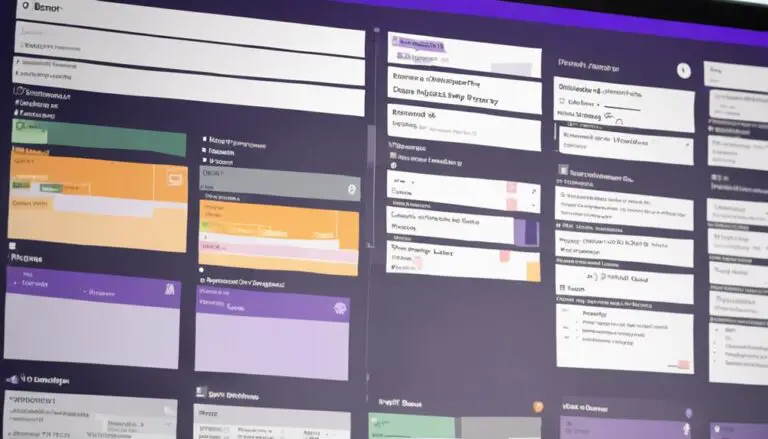When it comes to managing workflow efficiently, the saying 'Two heads are better than one' holds true in the realm of Kanban and sprints integration. You might be curious about how these two methodologies blend together seamlessly to optimize team performance and streamline processes.
Let's uncover how Kanban incorporates sprints to enhance workflow management and drive continuous improvement in a harmonious manner. One of the key principles of Kanban is to visualize the workflow, which allows teams to see the flow of their work and identify bottlenecks or areas for improvement. By incorporating sprints into the Kanban methodology, teams can set short-term goals and focus on delivering value in smaller increments, while still maintaining a continuous flow of work. This helps teams to maintain a steady pace, while also allowing for flexibility and adaptability as they move through the kanban workflow stages.
Key Takeaways
- Establish WIP limits and task progression within defined timeframes for efficient workflow management.
- Utilize Kanban boards to visualize tasks at different stages and track progress effectively.
- Set clear sprint durations and task allocation strategies for even distribution and focus.
- Regular reviews and adjustments enhance fine-tuning, prioritization, and workflow efficiency in Kanban Sprints.
Kanban and Sprint Integration
To seamlessly integrate Kanban with sprints for enhanced workflow management, establish clear WIP limits to regulate task progression within defined timeframes. By setting these limits, you ensure that work moves through the Kanban board in a smooth and controlled manner during Sprint planning. The Kanban board becomes a visual representation of tasks at different stages of completion, aiding in tracking progress and identifying bottlenecks efficiently. This integration allows for continuous improvement as team members focus on completing tasks within the Sprint while optimizing the workflow.
With WIP limits in place, the Kanban board becomes a dynamic tool for managing tasks in a Sprint. Tasks are broken down into smaller, manageable units, making it easier to track progress and make adjustments as needed. This collaborative approach ensures that the team stays aligned with Sprint goals and maintains a steady pace of work completion. Embracing Kanban and sprints together fosters a culture of continuous improvement, where efficiency and workflow optimization go hand in hand.
Planning Sprints in Kanban
Let's kick off the discussion on Planning Sprints in Kanban by focusing on three key points:
Sprint Duration Planning: By setting clear sprint durations, you can establish a rhythm for your workflow.
Task Allocation Strategy: Developing a smart task allocation strategy ensures that work is evenly distributed among team members.
Review and Adjust: Remember, regular reviews and adjustments are crucial for fine-tuning your Kanban sprint planning process.
Sprint Duration Planning
Incorporating Sprint duration planning in Kanban enhances task prioritization and time allocation for efficient workflow management. By setting specific time periods for completing tasks within a Sprint, teams in Kanban can better focus on their work and utilize Scrum principles for improved project management.
This structured approach helps teams utilize flow metrics to measure progress and identify bottlenecks quickly. Planning Sprints allows for a clear roadmap, ensuring that tasks are completed within defined timeframes.
With Sprint duration planning in Kanban, teams can collaborate effectively, increase task visibility, and enhance overall workflow efficiency. This iterative process of defining Sprint durations fosters a sense of belonging and shared responsibility within the team, leading to successful project outcomes.
Task Allocation Strategy
Utilize Kanban's task allocation strategy to effectively plan sprints for optimal workflow management. Task allocation involves breaking down work items into manageable chunks to be completed within predefined time periods.
When planning sprints in Kanban, it's crucial to assign tasks based on priority and capacity, ensuring workflow efficiency. By strategically distributing tasks, teams can maintain a steady workflow and focus on completing work within designated time frames.
Efficient task allocation in Kanban sprints facilitates progress tracking, workload management, and fosters continuous improvement in workflow management. Embrace this strategy to enhance collaboration, adaptability, and iteratively refine your workflow for better outcomes.
Review and Adjust
To optimize workflow efficiency in Kanban sprints, regularly review and adjust tasks within the workflow based on progress and performance metrics. Here are some key points to consider when planning sprints in Kanban:
- Engage Teams: Encourage collaboration among team members to review progress and identify areas for adjustment.
- Evaluate Work in Progress: Assess the status of tasks on Kanban boards to determine which items need attention or reevaluation.
- Continuous Review: Emphasize the importance of ongoing review and adjustment to maintain workflow efficiency.
- Enhance Workflow Efficiency: Make iterative changes based on feedback and metrics to improve overall performance and task management in Kanban sprints.
Kanban Sprint Planning Strategies
Enhance your sprint planning efficiency with Kanban's strategic workflow management techniques.
Kanban sprint planning involves utilizing flow metrics such as Work in Progress (WIP), cycle time, throughput, and task statuses to optimize your team's workflow.
By visualizing work progress on Kanban boards and tracking tasks from backlog to completion within sprints, you can identify bottlenecks and inefficiencies, improving overall process efficiency.
Limiting WIP and monitoring task completion times fosters better team collaboration and productivity during sprints. Integrating Kanban with sprint planning enables continuous improvement, clear workflow visualization, and optimized task management within each sprint.
These strategies help teams adapt to changes efficiently, iterate on their processes, and belong to a system that promotes effective workflow management. Embrace Kanban sprint planning strategies to enhance your team's productivity and achieve successful sprint outcomes.
Benefits of Combining Kanban and Sprints
When combining Kanban and Sprints, you'll experience increased task visibility, enhancing your team's ability to collaborate effectively.
This integration leads to improved workflow efficiency, allowing for better task management and streamlined processes.
Increased Task Visibility
By combining Kanban with Sprints, your team can significantly boost task visibility, facilitating the breakdown of work into manageable units for improved workflow management. Here's how this integration enhances your workflow:
- Clear Task Breakdown: Kanban boards visually represent sprint tasks, providing a clear overview of the workflow progress.
- Enhanced Transparency: Sprints in Kanban enhance transparency and accountability by showcasing task status and completion.
- Effective Tracking: The integration of Kanban and Sprints enables teams to track and monitor task flow effectively.
- Iterative Efficiency: By incorporating Sprints, Kanban promotes iterative task completion within specific time frames for enhanced workflow efficiency.
Enhanced Team Collaboration
Building on the foundation of increased task visibility, your team's collaboration reaches new heights through the seamless integration of Kanban and Sprints.
With the visual representation of tasks and progress on Kanban boards during Sprints, team members feel a sense of shared ownership that fosters a collaborative work environment. This shared responsibility not only improves communication but also enhances workflow management by creating transparency and accountability.
Improved Workflow Efficiency
To optimize workflow efficiency, harness the power of combining Kanban and Sprints for enhanced task visualization and time-bound productivity. By merging these methodologies, you can achieve improved workflow efficiency through:
- Clear Task Prioritization: Utilize Kanban boards to prioritize tasks and Sprints to focus on timely completion.
- Enhanced Team Collaboration: Encourage collaboration by visualizing tasks and setting sprint goals for better coordination.
- Streamlined Process Optimization: Identify bottlenecks and optimize workflows by combining the flexibility of Kanban with the structure of Sprints.
- Increased Productivity: Achieve timely deliverables and continuous improvement by integrating Sprints with Kanban for efficient workflow management.
Implementing Sprints in Kanban
When integrating sprints into Kanban, aim for streamlined task completion through time-boxed iterations within the workflow. Implementing sprints in Kanban enables you to break down projects into manageable chunks, enhancing efficiency in workflow management.
By setting clear goals and deadlines for each sprint, your team can focus on specific tasks or deliverables, fostering productivity and collaboration. These time-bound iterations in Kanban help prioritize work and provide a structured approach to completing tasks within the workflow.
With sprints, you can visualize progress, identify bottlenecks, and adapt quickly to changes, ensuring a smoother workflow. Embracing sprints in Kanban not only improves task completion but also boosts visibility and transparency throughout the process.
Enhancing Workflow Efficiency With Sprints
Enhancing workflow efficiency with sprints significantly boosts task completion rates and fosters seamless collaboration within the team. By implementing flow-based sprint planning in Kanban, you can optimize your workflow for better performance. Here are some key ways to enhance workflow efficiency with sprints:
- Focus on Task Completion Efficiency: Utilize sprint planning to set clear, time-bound goals for task completion, ensuring a steady workflow progress.
- Identify Performance Loopholes: Integrating sprints helps in pinpointing areas where performance can be improved, leading to enhanced overall workflow efficiency.
- Utilize Work Item Age Metrics: By tracking work item age within sprints, you can prioritize tasks effectively and ensure timely completion.
- Enhance Workflow Clarity: Integrating sprints in Kanban enhances workflow clarity, making it easier to visualize tasks and streamline processes for better team collaboration.
Synergy of Kanban and Sprint Methodologies
By integrating Kanban with sprints, your team can achieve a seamless workflow management system that enhances task prioritization and delivery timelines. Kanban's visual representation of tasks on a board combined with the time-bound goals set by sprints create a powerful synergy.
This integration allows teams to focus on completing tasks within defined time frames, fostering continuous improvement. The structured project management approach of sprints in Kanban ensures that tasks are completed efficiently while maintaining flexibility.
By incorporating sprints into Kanban, teams strike a balance between adaptability and organization, leading to optimized workflow management. This synergy not only streamlines task prioritization but also enhances delivery timelines, enabling teams to meet deadlines effectively.
Embracing the collaborative nature of Kanban and the iterative sprint methodology can propel your team towards greater productivity and success in project execution.
Frequently Asked Questions
How Does Kanban Work With Sprints?
In Kanban, you manage tasks without sprints, focusing on continuous flow and team collaboration. Embrace agile methodology, timebox tasks, visualize progress, and pursue continuous improvement. Adapt to change efficiently, delivering solutions at your pace.
How Do I Manage Sprints in Kanban Board?
To manage sprints effectively on a Kanban board, start by planning sprints, prioritizing tasks, and tracking progress daily. Use cycle time metrics for continuous improvement. With clear swimlanes, visualize and streamline your workflow seamlessly.
What Is an Effective Workflow for Kanban?
To establish an effective workflow in Kanban, prioritize tasks, encourage continuous improvement, foster team collaboration, visualize progress, limit work in progress, and track cycle time. This approach ensures efficient task management and optimized outcomes.
What Is the Sprint Goal in Kanban?
In Kanban, the sprint goal aligns tasks with customer needs, enhancing workflow efficiency. Through sprint planning, team collaboration, and continuous improvement, Kanban optimizes cycle time, work in progress, and capacity management, fostering a streamlined and value-driven workflow.
Conclusion
So, now you know how Kanban incorporates sprints for efficient workflow management.
Did you know that teams using Kanban boards combined with sprints experience a 56% increase in productivity?
By integrating these methodologies, teams can streamline processes, enhance collaboration, and achieve continuous improvement.
Keep implementing these strategies to optimize performance and achieve your project goals!





